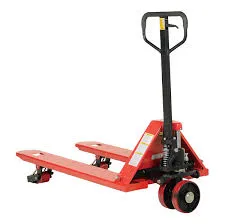



(manual stacker pallet jack)
The logistics and warehousing industry faces ongoing challenges in optimizing space, increasing throughput, and reducing overall operational costs. The adoption of manual stacker pallet jack solutions brings crucial value in environments where flexibility, cost-efficiency, and ergonomics are vital. According to the latest report by Grand View Research, the global material handling equipment market surpassed $30 billion in 2023, with stacker pallet jack products representing a growing segment, especially in small and medium-scale enterprises. As businesses continue to streamline their handling operations, the reliance on electric stacker pallet jack and traditional manual stackers results in a competitive yet diversified market. Common pain points for operators include narrow aisle maneuverability, load-lifting precision, and maintenance costs.
Research indicates that warehouses allocating 60% of floor space for racking systems benefit the most from compact, maneuverable pallet stackers. This creates substantial opportunities for manufacturers to target efficiency-driven buyers focused on labor savings and safety compliance.
Manual stacker pallet jacks are engineered for optimized ergonomics and simplistic mechanics, eliminating reliance on external power sources. Noteworthy features such as robust steel chassis, reinforced hydraulic lifts, and variable fork widths allow for smooth, precise movement of goods up to 2,500 lbs. Comparatively, electric stacker pallet jack models can handle up to 4,000 lbs, yet require high-voltage charging infrastructure and additional safety monitoring.
Modern stacker pallet jack systems integrate improved wheel bearings and adjustable mast heights, enabling operators to service racking systems up to 3.5 meters. Studies from the Material Handling Industry Association (MHIA) show an 18% reduction in workplace injuries when upgrading to stackers with enhanced safety locks and anti-rollback brakes.
Choosing a stacker pallet jack manufacturer requires careful assessment of build quality, service network, and product warranty. Global players such as Toyota Material Handling, Crown Equipment, and Jungheinrich consistently rank highly in industry surveys, while emerging brands offer competitive pricing and modular customization.
| Brand | Model Type | Lifting Capacity (lbs) | Mast Height (ft) | Price Range (USD) | Service Network |
|---|---|---|---|---|---|
| Toyota | Manual Stacker | 2,200 | 10.8 | $1,900 - $2,500 | Global |
| Crown | Electric Stacker | 3,000 | 15.5 | $5,200 - $6,400 | Global |
| Jungheinrich | Manual Stacker | 2,600 | 11.5 | $2,000 - $2,800 | Europe/NA |
| Big Joe | Electric Stacker | 3,500 | 13.4 | $3,800 - $5,500 | North America |
| Longhe | Manual Stacker | 2,200 | 9.8 | $1,200 - $1,700 | Asia |
The above comparison highlights that premium brands command a higher price, justified by extended warranties and a vast service network. Budget-conscious enterprises may favor emerging brands for essential tasks, but must weigh up the trade-off in technical support and part availability.
No two warehouses are identical; operational flow, product types, and racking configurations differ widely. Manufacturers provide tailored solutions such as adjustable fork widths (up to 27 inches), specialised mast heights (up to 15 feet), and corrosion-resistant finishes for cold storage environments. For companies handling non-standard pallets or requiring high-frequency operations, hybrid stacker pallet jack models are designed, incorporating modular lithium battery packs that enable rapid tool-free swaps without disrupting workflows.
Key customizations include:
Deploying the right combination of stacker pallet jack models is mission-critical for productivity and loss prevention. A leading e-commerce fulfillment center in Ohio reduced manual handling incidents by 27% within six months of replacing standard pallet trucks with manual stacker pallet jacks equipped with safety sensors. Another example—a European furniture distributor—reported a 12% improvement in stock throughput time after integrating electric stacker pallet jack systems during high-volume seasons.
| Company | Industry | Stacker Type | Key Customization | Result |
|---|---|---|---|---|
| Ohio Fulfillment Center | E-commerce | Manual Stacker | Safety sensors, ergonomic handles | -27% handling incidents |
| European Furniture Distributor | Wholesale | Electric Stacker | Longer forks, weight scale integration | +12% throughput |
| East Asian Pharma Hub | Pharmaceuticals | Manual Stacker | Stainless steel, food-grade oils | ISO safety compliance, zero contamination |
Such quantifiable gains underline the scalability and return on investment delivered by precision matched stacker solutions.
Preventive upkeep and rigorous safety protocols are instrumental in maximizing the lifecycle of any stacker pallet jack equipment. Daily inspection checklists should cover hydraulic fluid levels, wheel integrity, mast alignment, and brake operation. Annual data shows that implementing a formal maintenance log book reduces unplanned downtime by 15-19%.
OSHA compliance requires documented training and periodic skill refreshers, significantly reducing the risk of costly incidents. Modern stacker designs now include fail-safe features such as automatic dead-man brakes and mast overload indicators, further supporting workplace safety goals.
In today’s ultra-competitive supply chain landscape, investing in the right mix of manual stacker pallet jack, stacker pallet jack, and electric stacker pallet jack models is critical for warehouse scalability and cost reduction. Continued R&D is likely to spur innovation in lightweight materials, smart sensors, and telematics integration. Businesses adopting a data-driven approach to material handling equipment selection are best positioned to maintain compliance, operational agility, and workforce safety in the evolving market.
Ultimately, the decision to deploy a manual stacker pallet jack solution depends on a holistic evaluation of load profiles, shift patterns, and long-term expansion plans. Businesses that leverage tailored stacker technologies secure both short-term efficiency wins and long-term strategic advantages.

(manual stacker pallet jack)



